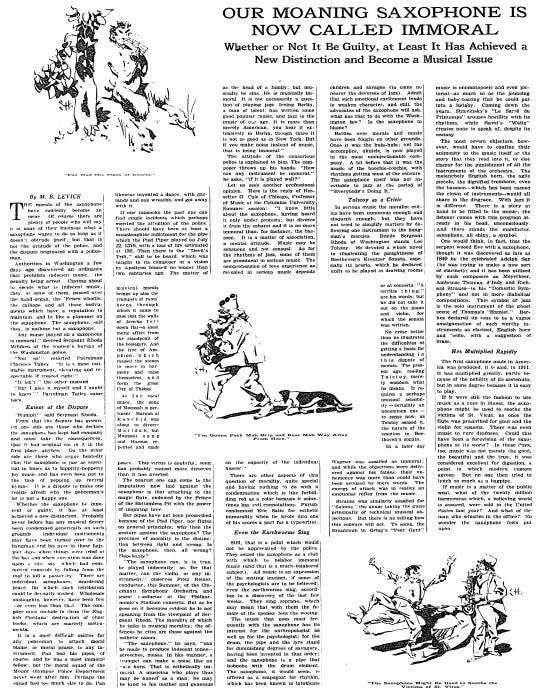Our Moaning Saxophone is Now Called Immoral
Whether or Not It Be Guilty, at Least It Has Achieved a New Distinction and Become a Musical Issue
Was the saxophone as an instrument a vessel for immorality? The Vatican declared it so in 1903. As the jazz age took off in the 1920s, a September 1925 New York Times Magazine article debated the issue.
Certainly jazz as a genre writ large was considered licentious and promiscuous in many corners, but not all instruments prominent in the genre came in for scorn. The saxophone, though, came in for special criticism for multiple reasons: from its honking sound to its shape that (some said) resembled a woman’s curves.
The journalist M.B. Levick interviewed multiple musicians. Quoting Fritz Reiner, conductor of the Cincinnati Symphony Orchestra:
“The saxophone can be made to produce indecent tones – screeches, noises. … That is aesthetically immoral. A musician who plays thus may be honest as a man; he may be kind to his mother and generous as the head of a family; but musically he sins. He is musically immoral.”
Quoting Rossetter G. Cole, Columbia University professor of music:
“Divorce [the saxophone] from the cabaret and it is no more immortal than, for instance, the bassoon. It is a matter of association, a mental attitude.”
Now in 2025, the saxophone is hardly considered immoral, being played by everyone from Lisa Simpson to President Bill Clinton. (Who may have done immoral things with interns in the White House, but unrelated to the saxophone.)
Indeed, while 1954’s movie A Streetcar Named Desire was censored for a scene featuring a saxophone score, at no point in the past half-century or more has the saxophone proved a source of controversy in music. Indeed, the most controversial songs of the modern era usually don’t even feature analog (non-digital) instruments at all.
Our Moaning Saxophone is Now Called Immoral: Whether or Not It Be Guilty, at Least It Has Achieved a New Distinction and Become a Musical Issue
Published: Sunday, September 13, 1925


